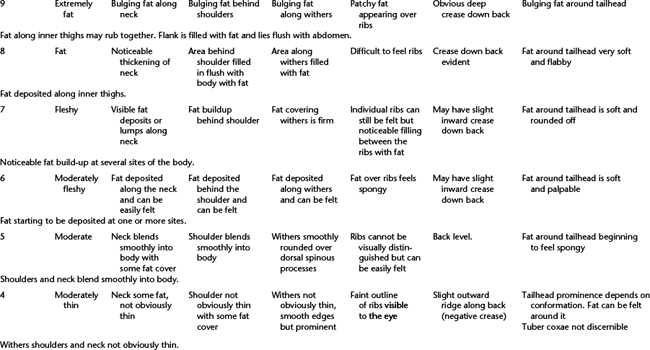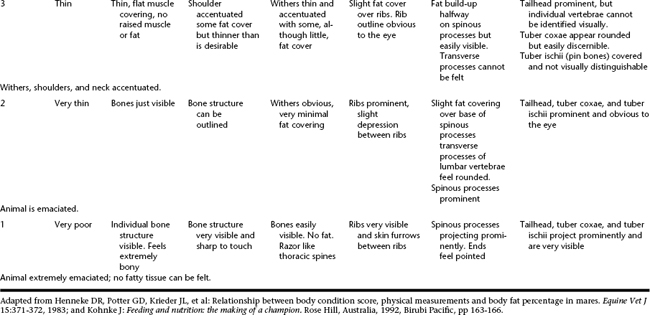CHAPTER 15 Dietary Management of the Obese Horse
Obesity is an emergent problem in companion-animal equids. Obesity has been associated with insulin resistance in horses and ponies, and both obesity and insulin resistance have been associated with increased risk of laminitis, particularly the pasture-associated form of this disease. Recognition of these adverse consequences of obesity has evoked increased interest in strategies for weight loss and management in obese equids, including diet and exercise. This chapter provides a brief overview of the prevalence, causes, and consequences of obesity in horses and ponies and a more detailed description of current recommendations for dietary management of this condition. The importance of regular physical activity for treatment of obesity is also discussed.
ASSESSMENT OF ADIPOSITY IN THE HORSE
In horses, the most widely applied method for assessment of adiposity is evaluation of body condition according to a 9-point scale developed by Henneke. This system of body-condition scoring (BCS) assesses subcutaneous fat deposition in six areas: crest of the neck, withers, behind the shoulder, over the ribs, along the back, and around the tailhead. There can be considerable interhorse variation in patterns of fat deposition; for example, some horses deposit little fat over the ribs even when other areas of the body are well covered. In addition, fat deposits are sometimes asymmetric in distribution. It is therefore important to evaluate all six areas of the body on both sides. A score between 1 and 9 is assigned, where 1 indicates severe emaciation and 9 indicates extreme fatness (Table 15-1). Our preference is to assign a score to each of the six areas, with the overall BCS taken as an average of these individual scores. It has been estimated that each BCS unit (on the 1 to 9 scale) in a typical Thoroughbred, quarter horse, or Arabian weighing 450 to 500 kg represents approximately 20 to 25 kg of body weight, although data in this area are scant.
The ratio of mean neck circumference to height at the withers (NCHR) has been used as a measure of neck adiposity. In preliminary studies, the NCHR was more closely correlated with measures of insulin resistance than with BCS. Although cutoff values for NCHR in relation to obesity and disease risk have not been defined, repeated measurement of mean neck circumference is useful for monitoring the effectiveness of a weight loss program. In this context, regular assessment of BCS and body weight is recommended. Ideally, body weight is measured by use of a calibrated large-animal scale. As an alternative, weight can be assessed by formulae that include measurements of girth circumference, such as those used in weight tapes. Such formulae tend to be more accurate when used on mature horses with a BCS in the range of 5 to 7. It should also be recognized that weight estimates based on heart-girth measurements do not account for variation caused by hydration state, pregnancy, and the weight of intestinal contents.





